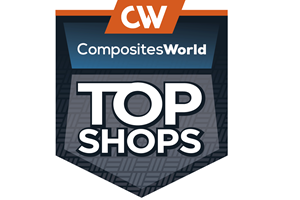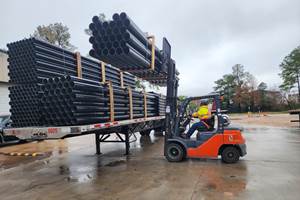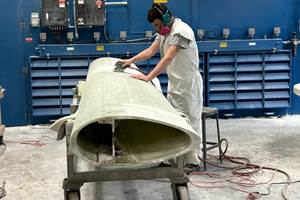Top Shops Benchmarking Survey FAQs
CompositeWorld’s Top Shops Benchmarking Survey is gearing up for 2025. Gardner Business Intelligence, the research arm of Gardner Business Media, offers some insights for taking the survey and interpreting the results.
Top Shops is a tool in your toolbox. It is one source of data, albeit a robust collection of metrics, that reveals tons of information that is otherwise not available. While it is impossible to make the survey a perfect fit for every size and type of manufacturing facility out there, it is designed to help you understand where you stand in your industry. Approaching the Top Shops report with this in mind, you can generally make sense of numbers that may not make sense at first blush and/or compare back to your own past surveys. It is also important to keep in mind how your shop is different. It is fair to factor in those differences when you are interpreting Top Shops results.
Q. My business has several locations. Do I answer one Top Shops survey for all of them combined, or complete separate surveys for each location?
A. Answer according to how you keep your books. If metrics like profit margin and sales revenue are combined across locations for managing the business, that is how you’ll want to submit your answers. If, on the other hand, the books are kept, and only kept, by location, you should complete separate surveys for each.
Q. My facility is small. We have just one manager/owner and six other employees. How can we possibly compete for Top Shops status when we are compared to shops multiples of our size?
A. We do what we can to put shops on a level playing field when it comes to size. Many questions with numeric responses are worded in ways that take facility size out of the equation. That means asking survey participants to calculate answers that divide values (such as sales revenue) by number of employees and/or number of machines. Sometimes we do those calculations behind the scenes, using values participants provide. Either way, this practice achieves a degree of “equalization” across businesses.
Q. I cannot answer all of the questions. Some just do not apply to me/my business. Does that count against me?
A. Honestly answer all Top Shops questions that you can. Skip those that you really cannot answer or select “does not apply” if that response option exists for the question (it sure should, whenever “does not apply” is a real possibility).
Q. Can you just tell us which questions are scored? That way we can be sure to answer the questions that count.
A. Score-based top shops status is just one objective of the program. Benchmarking is another key objective. Answering all questions contributes the most to Top Shops’ objectives. If we were to ask only scored questions, some of the diagnostic “why’s” would be lost. There is also the risk that it becomes easy to game the system.
Q. Shops are not created equal in terms of the work they do. I am familiar with a few Top Shops near me, and some of them are super specialized doing fantastic work manufacturing only a few “intricate” parts. Our business handles large quantities of simple parts. I would expect a specialized shop to score better every time.
A. The way we ask questions and interpret results acknowledges those types of differences. We do our best to put everyone in the same mindset with formulas and examples to not advantage or disadvantage shops based on profile information, including industries served.
Q. How can you be sure everyone answers honestly? Oftentimes, when I go through my custom report, I seriously question some of the values submitted. They seem too good to be true.
A. Answers are self-reported according to the honor system. Benchmarking relies on honest answers, and our observation is that most survey participants support that objective. We do remove the occasional outlier with extreme or otherwise fraudulent responses.
Q. How can it be that a super high value lands in just the 80th percentile?
A. It is typically a function of the metric having a lot of participants clustering around the same (often very low or very high) value. Examples are accident incidents and turnover rates. Everyone works on having low values for these metrics, so there is little distribution of responses.
Related Content
CW Top Shops 2022: Recognizing composites industry leaders
The highest-performing facilities from the 2022 CW Top Shops benchmarking survey share insights about business growth, overcoming labor shortages, sustainability best practices and more.
Read MoreCW Top Shops 2023: Honoring global top-performing facilities
CW congratulates the 2023 CW Top Shops honorees and composites fabricators whose leaders cite team expansion, focus on Industry 4.0 and adaptation to emerging markets among this year’s top achievements.
Read MoreFiberglass conduit manufacturer grows into new products, infrastructure applications
Texas-based Champion Fiberglass, a five-time CW Top Shops honoree, expands its success in the fiberglass composite conduit market into new applications and products, looking toward future automation and sustainability initiatives.
Read MoreDefense manufacturer reflects on growth, opportunity in complex composite structures
Long Island-based, four-time CW Top Shops honoree GSE Dynamics cites diversification in processes, digitalization, workforce training and more on its successes over 50+ years, and looks ahead to future growth.
Read MoreRead Next
Composites business growth through diversification, innovation
San Diego-based 2024 Top Shops qualifier Rock West Composites gives an overview of its relentless commitment to improvement, including its composite capabilities and its role as a trusted player in the space market.
Read MoreCompositesWorld reveals 2024 Top Shops benchmarking survey results
CW recognizes the qualifying composites fabricators in its 2024 Top Shops program and highlights some of the survey's general findings.
Read MoreAll-recycled, needle-punched nonwoven CFRP slashes carbon footprint of Formula 2 seat
Dallara and Tenowo collaborate to produce a race-ready Formula 2 seat using recycled carbon fiber, reducing CO2 emissions by 97.5% compared to virgin materials.
Read More














